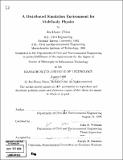| dc.contributor.advisor | John R. Williams. | en_US |
| dc.contributor.author | Chiou, Jen-Diann | en_US |
| dc.date.accessioned | 2010-01-07T20:47:21Z | |
| dc.date.available | 2010-01-07T20:47:21Z | |
| dc.date.copyright | 1998 | en_US |
| dc.date.issued | 1998 | en_US |
| dc.identifier.uri | http://hdl.handle.net/1721.1/50509 | |
| dc.description | Thesis (Ph.D.)--Massachusetts Institute of Technology, Dept. of Civil and Environmental Engineering, 1998. | en_US |
| dc.description | Includes bibliographical references (leaves 128-134). | en_US |
| dc.description.abstract | A distributed simulation environment, which can be used to model multibody physics, is developed. The software design is based on the object oriented paradigm and is implemented in C++ to run on a single workstation or multiple processors in parallel. It provides facilities to set up a multibody physics simulation, including arbitrary 3D geometric representation, particle interactions such as contacts and constraints, and visualization for postprocessing. Contact detection, the process of automatic identifying the geometric overlap between objects, is generally the most time-consuming procedure in the overall discrete element analysis pipeline. The computational cost of contact detection grows as a function of both the number of particles and the complexity of the geometric representation of each body. This thesis presents algorithms that significantly reduce the computational cost of the contact detection problem. The hashtable-based spatial reasoning algorithm demonstrates an O(M) performance, where M is the number of particles in the simulation system for a restricted set of particles. The discrete function representation (DFR) scheme is employed to model the surface geometry of complex 3D objects. DFR-based contact detection between a pair of objects exhibits an O(N) running time performance, where N is the number of surface point used to represent each object. In practice this results in a significant speedup over traditional techniques. A distributed DEM simulation environment is built on top of a set of software tools which exploit the parallelism embedded in the DEM analysis and which take advantage of a high-speed communications network to achieve good parallel performance. The goal is of reducing the entire computing time of of large-scale simulation problems to order O(N) is shown to be achieveable using the algorithms described. | en_US |
| dc.description.statementofresponsibility | by Jen-Diann Chiou. | en_US |
| dc.format.extent | 134 leaves | en_US |
| dc.language.iso | eng | en_US |
| dc.publisher | Massachusetts Institute of Technology | en_US |
| dc.rights | M.I.T. theses are protected by
copyright. They may be viewed from this source for any purpose, but
reproduction or distribution in any format is prohibited without written
permission. See provided URL for inquiries about permission. | en_US |
| dc.rights.uri | http://dspace.mit.edu/handle/1721.1/7582 | en_US |
| dc.subject | Civil and Environmental Engineering | en_US |
| dc.title | A distributed simulation environment for multibody physics | en_US |
| dc.type | Thesis | en_US |
| dc.description.degree | Ph.D. | en_US |
| dc.contributor.department | Massachusetts Institute of Technology. Department of Civil and Environmental Engineering | en_US |
| dc.identifier.oclc | 42363833 | en_US |
